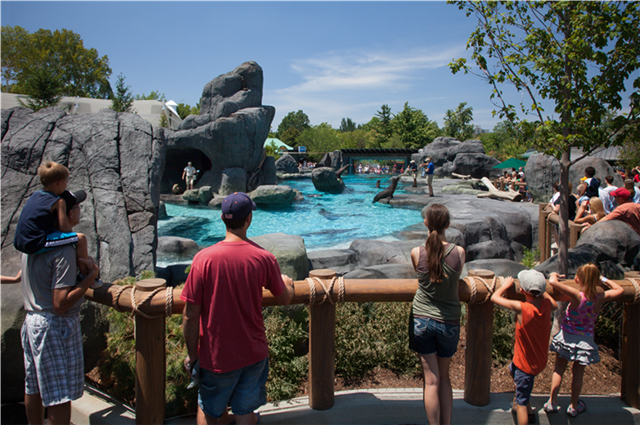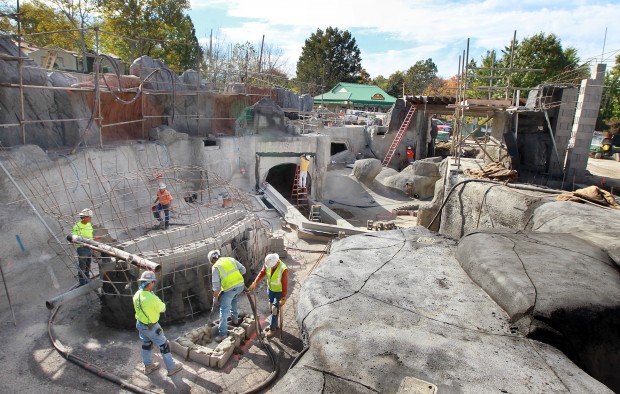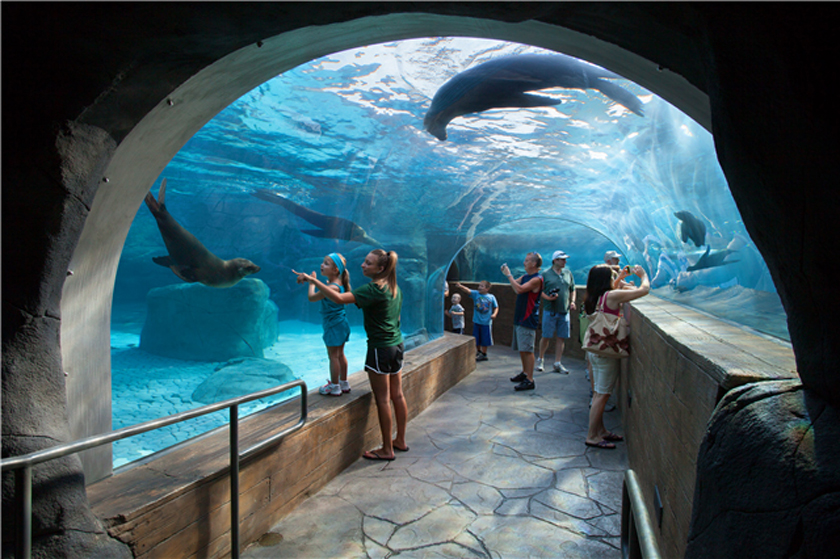 This summer was an exciting one for the sea lions at St. Louis Zoo! On June 30, 2012, a new, state-of-the-art PGAV-designed exhibit and amphitheater was officially opened after years of design and construction--on the very spot of their old exhibit. Located in what is referred to as the 'Historic Basin', Sea Lion Sound anchors the core of the zoo, right at the major crossroads for north-south circulation and the eastern spur. The exhibit was the first to be completed from the most recent master plan also completed by PGAV.
Below is a fly-through video of the Sea Lion Sound original design.
This summer was an exciting one for the sea lions at St. Louis Zoo! On June 30, 2012, a new, state-of-the-art PGAV-designed exhibit and amphitheater was officially opened after years of design and construction--on the very spot of their old exhibit. Located in what is referred to as the 'Historic Basin', Sea Lion Sound anchors the core of the zoo, right at the major crossroads for north-south circulation and the eastern spur. The exhibit was the first to be completed from the most recent master plan also completed by PGAV.
Below is a fly-through video of the Sea Lion Sound original design.
[youtube http://www.youtube.com/watch?v=zS6wrJnSPas]
The $18 million project features a large exhibit with both underwater and overwater views, a large open-air, shaded amphitheater and show pool (complete with sea lion slide!), holding facilities and underground LSS yard. Exhibit viewing is completely unique to sea lion exhibits in the United States, and features a 23 foot tall flat panel as well as the crown jewel, a 35 foot long acrylic tunnel. The show pool is also fronted in acrylic to allow both underwater and overwater enjoyment.
 Recently, I was able to interview a PGAV staffer who was instrumental in the creation of Sea Lion Sound, Rosey Masek-Block, about the specifics of the project.
Recently, I was able to interview a PGAV staffer who was instrumental in the creation of Sea Lion Sound, Rosey Masek-Block, about the specifics of the project.
DZ: What was your official role in the project, Rosey?
RMB: Construction Administrator. I attended weekly meetings with the CM [Construction Manager] and GC [General Contractor] to address any questions or concerns that had come up.
DZ: What was the most challenging aspect of your job?
RMB: Providing answers quickly when unforeseen conditions arose. A lot of times there would existing site conditions, weather conditions, or delayed deliveries that would affect what was going on. Any long delay in an answer would delay the construction.
 DZ: What was the most satisfying?
DZ: What was the most satisfying?
RMB: Seeing the Sea Lions happily swimming and performing. Also attending the shows incognito and having the public sit by you and express how excited they were that THEIR zoo has something this new, beautiful, and exciting.
DZ: That must be so amazing! Now, let's get into some specifics. How big is the total project area?
RMB: The total construction site is about 1.5 ares.
 DZ: How many animals will be living here, and what species are they?
DZ: How many animals will be living here, and what species are they?
RMB: Right now there are 10 California Sea Lions and 1 Harbor Seal. 3 of the Sea Lions were born at the STL Zoo. It was designed to accommodate 10-15 sea lions. {Steve Bircher, curator, says the zoo may adopt or breed sea lions in the future, but has no plans to take in any additional seals.}
 DZ: How many gallons are in the total system? How many per pool?
DZ: How many gallons are in the total system? How many per pool?
RMB: The entire system is roughly 250,000 gallons. All the pools are linked together, but roughly the main exhibit pool makes up about 190,000.
DZ: How big is the Exhibit, in area?
RMB: The Exhibit itself is about 11,000 square feet.
DZ: How many seats in theater?
RMB: There are approximately 830 seats, give or take a few, as it is bench style seating.
DZ: What were the design goals for the project?
RMB: I wasn’t on the design team for this [project] in the beginning, [but according to them] there were a few main things we were hoping to achieve: To provide the feel of the Pacific northwest in the rockwork, buildings, and surroundings (mimicking the natural habitat). To keep the profile of the exhibit as low as possible--we still wanted to preserve as much of the views looking up/down historic hill as possible. To provide an up-to-date filtering system to reduce water waste, and to provide an entertaining and playful environment for the animals and the people. The tunnel needed to be low enough to provide enough space for animals to feel comfortable on both sides of the exhibit. After all, they sometimes express just as much curiosity looking at the people as the people do looking at them.
DZ: That's absolutely true. Sometimes we underestimate the power of the visitor as a form of animal enrichment! Is there a conservation message? How is it presented (show or exhibit?)?
RMB: Water Conservation is probably the biggest. Originally the old exhibit was a dump and fill pool. The new system filters the water rather than replacing it. {Dr. Jeffrey Bonner, Zoo President, recently stated that since the species of sea lions and seals living in this exhibit are not endangered, he believes this exhibit to be more about educating guests about the animals rather than about conservation.}
 DZ: What were the main components to the design…theater, exhibit, holding, what else?
DZ: What were the main components to the design…theater, exhibit, holding, what else?
RMB: The Life Support Systems Basement. Most people can’t tell that under the little holding buildings is a 2 story basement containing all the equipment needed to keep the exhibit healthy and beautiful. Also providing shade for the public as well as the animals was a huge part of the project.
DZ: What other animal projects have you worked on? Do you think of yourself as a zoological designer or just an architect that happens to have worked on animal projects?
RMB: I’ve been a part of STL Zoo Bear Design and the design team for a project at Columbus Zoo. Right now I would consider myself an architect working TOWARDS becoming a zoological designer.
 DZ: What a great way to think about it! You've certainly gotten some significant experiences under your belt!
DZ: What a great way to think about it! You've certainly gotten some significant experiences under your belt!
RMB: I enjoyed being part of the process – I feel really proud when I take people to my local zoo and can say I was part of helping make it great.
 Thanks for your time and dedication, Rosey! Congratulations everyone who contributed to this wonderful project.
Thanks for your time and dedication, Rosey! Congratulations everyone who contributed to this wonderful project.























